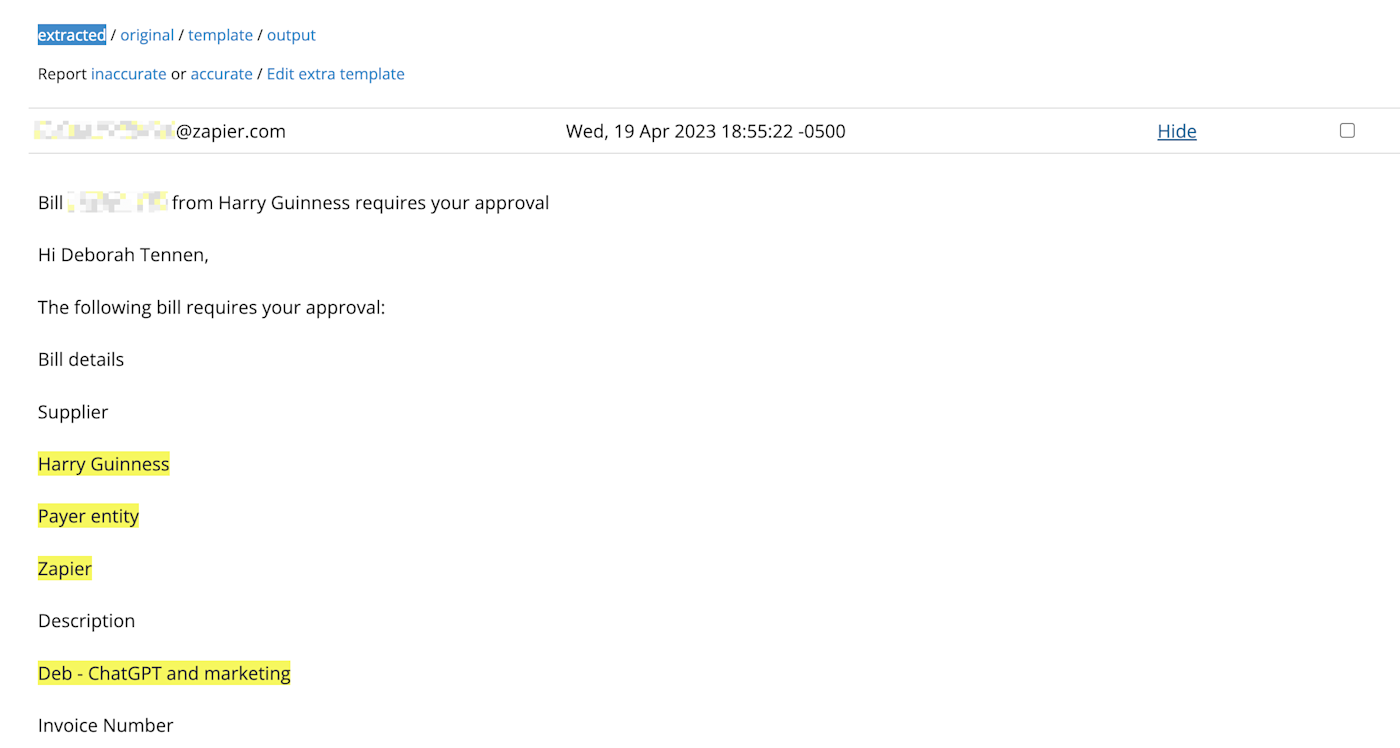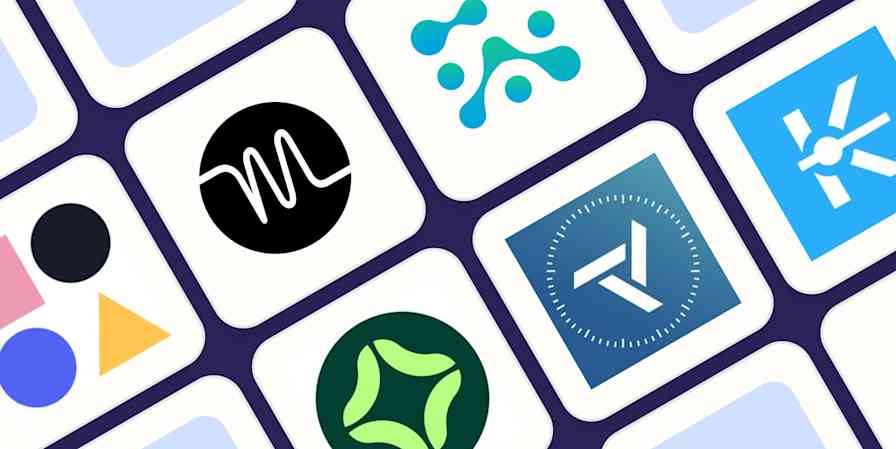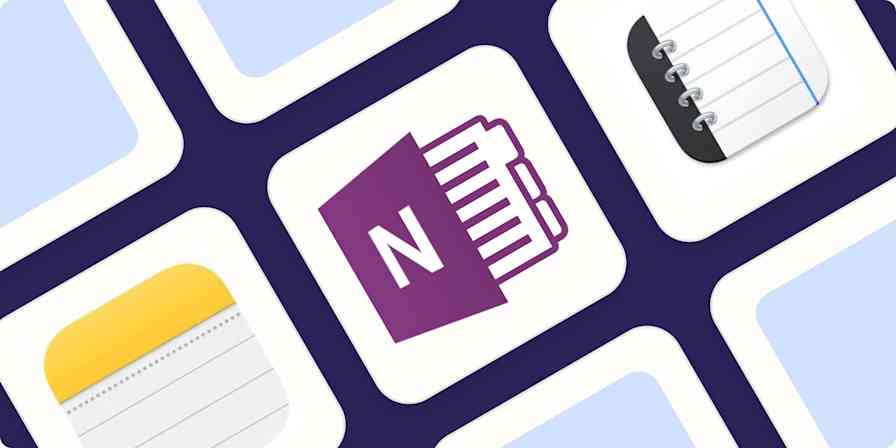Your inbox has more than just emails—it's full of data. This is particularly true if you run a business. Maybe your leads come in via email, maybe that's where certain invoices end up, or maybe it's where all your onboarding survey results go.
But you can't do much with this data if it stays buried deep in your inbox among the newsletters, shipping notifications, and spam. Receipts are more useful in your bookkeeping software, for example. Contacts are more useful in your CRM. While you could manually copy all that information over, especially if there are only a handful of relevant emails, it's still an annoying bit of work—and definitely doesn't scale to dozens or even hundreds of emails a day.
This is where email parsing tools come in. These tools do the work for you, grabbing information from your inbox and organizing it in such a way that other apps can make use of it.
For years, email parsers were kind of awkward to use. You had to manually create rules using things like regular expressions, if-this-then-that logic loops, and other kinds of code and pseudocode. If you could fine-tune things, amazing—until the format of the emails you were scraping changed and you had to update things all over again. But over the past two years, there's been a big technology shift: now you can parse emails using AI.
And this is a really big shift. Large language models are flexible enough that when you tell one to grab the date from an email and format it in a particular way, it will—regardless of how the date appears in the email. There's still some tweaking to do to get everything working right, but email parsing tools are no longer awkward Rube Goldberg machines held together with weirdly specific rules.
So, whether you're just curious about email parsing tools or are looking to upgrade to a much simpler tool, here are the best email parsing apps available right now.
The best email parsing software
Airparser for a GPT-powered email parser
Email Parser by Zapier for an entry-level parser for Zapier users
Parsio for a multi-purpose email parser
Parseur for advanced users and for parsing email attachments
What makes the best email parser software?
How we evaluate and test apps
Our best apps roundups are written by humans who've spent much of their careers using, testing, and writing about software. Unless explicitly stated, we spend dozens of hours researching and testing apps, using each app as it's intended to be used and evaluating it against the criteria we set for the category. We're never paid for placement in our articles from any app or for links to any site—we value the trust readers put in us to offer authentic evaluations of the categories and apps we review. For more details on our process, read the full rundown of how we select apps to feature on the Zapier blog.
There are only a dozen or so true email parsers available, so I tested every one I could get my hands on and selected the best. I've been testing and reviewing automation software for over a decade, so I have a lot of experience evaluating apps like this. The best email parsing apps meet the following criteria (and some go above and beyond):
They extract specific information from your email and its attachments. This can be done using custom rules, using templates offered by the app itself, by automatically scanning all incoming emails for particular data, or increasingly, using AI models to detect relevant information. Accuracy is important here as you need your email parser to reliably grab the data you want every time.
They're easy to set up and use. Email scraping services used to be pretty tricky to set up. You had to manually create a series of rules that would allow one to extract the data you wanted from an email. Now though, AI can do a huge amount of the heavy lifting for you. Even compared to last year, the email parsing tools available are genuinely easy to use. It's a big change, and it's really shaken up the list this year.
They put that data where you want it. Some people are going to want to download a spreadsheet every now and then, and most of the apps in this category offer that. The best ones, though, can send data to the other applications you already use. That way, your receipts can be sent straight to your accounting software, or your new clients' contact details can be added to your CRM and mailing list automatically.
They're nice to use. Specialized tools like email parsers are often built with a technical end user in mind—which means many apps skimp on things like onboarding and a nice user interface. While not essential, helpful tips, tutorials, and an inoffensive interface make the best email parsers a little more pleasant to use. These certainly aren't apps for everyone, but ideally they should be apps for anyone.
In some cases, I found apps that offered similar features and quality at different price points, and in those instances, I favored the more affordable or easier-to-use option.
Why parse email? Email parsers vs. email rules
Most email services, like Gmail and Outlook, have some kind of automated rules system that you can use to filter and sort emails. The difference between dedicated email parsers and these rules comes down to one key distinction: Gmail and Outlook can sort your emails based on their contents, while an email parser can directly sort the contents.
For example, with Gmail, you can automatically tag all emails that contain invoices, so you can send them to your accountant at the end of the year. With an email parser, you can pull out the date sent, the invoice number, and the date it was paid out—and, with the help of an app like Zapier, add that to a spreadsheet, and have it automatically sent to your accountant on the second Tuesday of every month.
Many people are probably fine with the built-in automation of their email service, but if you run a business, need to process the data that's actually in your emails, just have a huge volume of emails that needs to be dealt with, or really like automating these kinds of things, then an email parser is definitely for you.
The best email parsers at a glance
Best for | Standout features | Pricing | |
|---|---|---|---|
GPT-powered email parsing | Easy setup and powerful extraction capabilities | Free trial with 30 credits; from $29/month for 100 credits | |
And entry-level email parser for Zapier users | Allows setting up multiple mailboxes; easy automation | Included with all Zapier plans | |
Multi-purpose email parsing | Flexible and customizable extraction options | Free for 30 credits/month; from $49/month for 1,000 credits | |
Advanced users and processing attached documents | Powerful OCR features | Free for 20 documents/month; from $39/month for 100 credits |
Best GPT-powered email parser
Airparser (Web)

Airparser pros:
Incredibly easy to use
Powerful GPT-powered email parsing
Prompts allow you to extract and structure data
Airparser cons:
Expensive, especially on lower plans
Airparser is an AI-powered email parser developed by Parsio, one of the other apps on this list. It's a separate product because it depends almost entirely on OpenAI's GPT to extract information from your emails, PDF documents, text files, and with OCR, even images. It's super powerful and really easy to use.
With Airparser, every inbox—though you can also upload files manually or using the API—has its own extraction schema. This is what structures the data you're trying to pull from an email, document, or other file. However, instead of creating rules or some kind of logic chain, you name the piece of data you want and then write a descriptive prompt that tells AI what to get. I was able to use things like "the time formatted in US standard time" to get it to extract 13:10 and save it as 1:10 pm and "literally all the text in the image" to have it strip all the OCRed text it could see. You can also create lists and tables with prompts for each item or cell.
Best of all, Airparser automatically formats things as JSON, so you can use its built-in Python post-processing to manipulate it, or send it directly to another app using Zapier. This means you can do things like send all your transactions straight to your accounting software or add new contacts to your CRM.
The big downside is the price. The Starter plan costs $39/month and only gets you 100 credits per month—that means each processed email costs $0.39. Things are much better on the $59/month Growth plan (500 credits per month/~$0.12 per email) and $179/month business plan (2,000 credits per month/~$0.09/email). So if you're a high-volume user, Airparser could be quite good value—but if you're only parsing a few dozen emails per month, it'll be a pricey option.
Airparser pricing: Free trial with 30 credits; Starter plan with 100 credits per month from $29/month
Best entry-level email parser for Zapier users
Email Parser by Zapier (Web)

This is a Zapier product in a Zapier blog post, so I understand if you're skeptical about my ability to be neutral. But I'm not going to pretend this is the most powerful email parsing tool here—and if you don't need the other solutions Zapier offers, it might not be right for you. But if email parsing is just one of many automations you'll use, it gets the job done. If you're already paying for Zapier, even better.
Get started with Email Parser by Zapier, and you can set up as many mailboxes as you want, each with its own @robot.zapier.com email address. You can forward emails to that address, either manually or using something like Gmail's filter system. Send a few sample emails, then highlight and name the information you'd like to scrape from future emails. You won't find many advanced features here—you can't scrape the contents of email attachments, for example.
Then you'll set up a Zap, Zapier's term for an automated workflow, which is what will send that information to whatever other app you want—you can choose from thousands of apps, or even send the contents off to be handled by an AI like ChatGPT.
A few examples of what you can do with the scraped contents: send information from your email to a spreadsheet, add new contacts to a Mailchimp list, or create a Google Calendar event based on the specified time and date in the email. Learn more in our email parser guide, or get started with one of these pre-made templates.
Get new Zapier Email Parser emails in Slack messages
Email Parser by Zapier pricing: Included with all Zapier plans.
Best multi-purpose email parser
Parsio (Web)

Parsio pros:
Super flexible
Affordably priced with a great free plan
Parsio cons:
You don't have as much control over how the AI extracts data as you do with Airparser
Parsio has a lot in common with Airparser—which is no surprise given that both tools were built by the same team. It offers template-based parsing, GPT-based parsing, and PDF-parsing using pre-trained AI models, so it's one of the most flexible tools on the list.
The template-based parsing is as good as such a finicky kind of thing can be. You select a chunk of text in your sample document and assign it to a data field or table. If nothing changes, it will work—but if something changes in the format of the email or document, your email parsing will break.
But Parsio now has two kinds of AI-powered parsing, which is where it really stands out. With GPT-powered parsing, you simply write a prompt directing it to do something like "extract the name, contact number, date of application, and email address of the job applicant" or "find the weather and format it as a table" from almost any kind of document. If you've ever tried something similar with ChatGPT, you'll know how good AI can now be at this kind of thing.
The pre-trained PDF and image parsing is super interesting. Parsio has AI models to extract content for invoices, receipts, tax forms, ID documents, and other kinds of documents. They can also use OCR to extract data from scanned and hand written documents.
Parsio works using a credit system. It costs one credit per page to use the template-based parser (and an additional one credit to parse an email signature), two credits per page to use the GPT-powered-parser, or five credits per page to parse an attachment with a pre-trained AI model. The free plan offers 30 credits per month, while paid plans start at $49/month with 1,000 credits.
Parsio offers post-processing and integrates with Slack, Shopify, and loads of other apps natively—including Zapier. That means you can do things like automatically create Google Sheets or Airtable records from parsed documents. Here are a few more examples.
Create Google Sheets rows for newly parsed documents in Parsio
Send Slack channel messages for newly parsed Parsio documents
Add Microsoft Excel rows for newly parsed Parsio documents
Parsio pricing: Free for 30 credits/month; from $49/month for Starter plan with 1,000 credits/month.
Best email parser for advanced users and processing attached documents
Parseur (Web)

Parseur pros:
A fully featured and flexible email parser with great templates and a solid AI
Decent free plan
Parseur cons:
Expensive, especially on lower plans
Parseur is another flexible email parser like Parsio. You can use both templates and AI to extract data from emails and an inexplicably long list of file formats. If you need to pull a contact number from an ODT, RTF, Apple Pages, or even a WordPerfect file for some reason, it has you covered. It's also got some pretty powerful OCR features, like dynamic OCR that can find fields that move or change size in a document or email.
In terms of AI, Parseur falls somewhere between Airparser and Parsio. You can be a little more hands-on with what it extracts, but you don't have the same level of control and customization that Airparser offers.
And there's a lot more to like too. There's post-processing support, for example, using Python scripts (at a higher price point) and lots of integrations—including Zapier, so you can send scraped data from your email to thousands of apps. Learn more about how to automate Parseur, or try these pre-made workflows.
Create new Airtable records from Parseur parsed email data
Add rows to Google Sheets for new table fields processed in Parseur
The downside: Parseur can be expensive, especially if you rely on its templates. It uses a credit system: it costs one credit to parse one email or one page of an attachment. The free plan gets you 20 credits/month, but after that, the cheapest plan is 100 credits/month for $39. $0.39 per email or page of an attachment might be worthwhile if you want access to both a template system and an AI, and the price per credit goes down rapidly with higher monthly fees, so try Parseur out before you decide on a service.
Parseur pricing: Free for 20 documents a month; from $39/month for a plan with 100 credits/month.
Other email parsing software
AI has dramatically changed email parsing in the last couple of years, which is awesome for users, but it's meant that some apps I used to love now feel a bit dated. With apps like Airparser, Parsio, and Parseur making it super easy to extract data from emails, there's now no reason for most people to use a tool that makes things a bit more awkward.
Still, if you're comfortable with the technical side of things or want something a bit different, there are a few other email parsing apps worth considering:
Mailparser (which you can automate with Zapier) had one of my favorite template setups, but its AI features aren't as solid as the options on this list. Hopefully they'll improve and I can fully recommend it again next year.
Parserr has some neat AI features, but the interface is a bit confusing.
Nanonets has some of the most powerful AI parsing features around, but with a limited free plan and a starting price of $999/month, it fell outside the scope of the other apps I tested.
Email Parser is the only service I looked at with a desktop Windows app. If that's what you want, give it a look.
SigParser can search through your emails and pull out all the contact details in signatures. It was a bit too limited to make the list this year, but the service is solid.
It's exciting to see the current AI boom turn once-complex apps into easy-to-use no-code tools. While there's a lot of hype around chatbots and the like, some of these lower-key upgrades to the tools that individuals and businesses rely on every day are likely to have just as much impact. If you're still parsing your emails with creaky old Gmail rules or copying and pasting things into spreadsheets, give one of these apps a try.
Related reading:
This article was originally published in January 2021 by Justin Pot. The most recent update was in April 2024.





